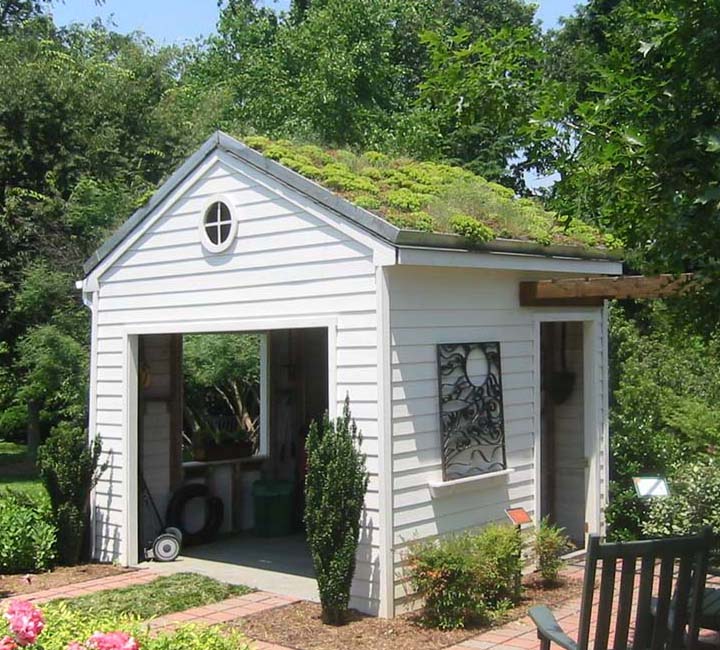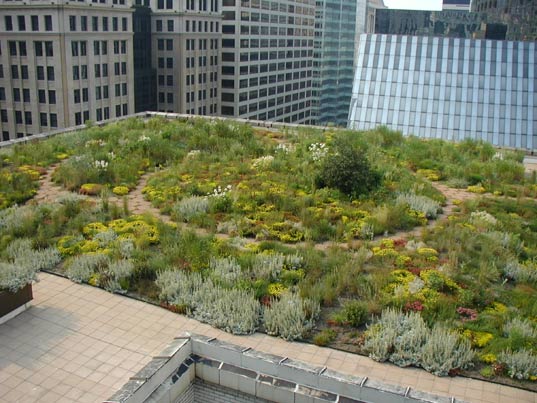The Green Roof — A Garden Oasis in the Urban Landscape
by Elizabeth Cornell Fake, Fairfax Master Gardener

Green Roof at AHS River Farm
The green roof, also called the roof garden, living roof, vegetative roof or eco-roof, has been growing in popularity for the past few decades all over North America as part of the Living Architecture movement. In areas like Northern Virginia, where increasing urbanization and expansive growth of suburbs compete with environmental sustainability, the green roof is a practical solution of interest to the gardening community. Those interested will want to know the benefits, disadvantages and growing conditions for the green roof plus some tips for plant selection, maintenance and disease and pest management.
Broadly defined, the green roof is a thin layer of vegetation on top of the roof of a residence or commercial building. It can be a pitched or flat roof surface that adds beauty and visual interest to urban structures. But, beyond beauty, there are many benefits that come from adding a green roof to the landscape. Green roofs are known to improve air quality, enhance energy efficiency, extend roof lifespan, increase property values, retain stormwater and reduce runoff. They also lower temperatures in urban heat areas, reduce noise pollution, provide habitat and enhance biodiversity. These benefits will increase the quality of life and reduce stress by transforming the urban cityscape into a calming oasis of nature.
On the downside, the cost for green roof installation can be far more than a regular roof because of the need for specialized materials and skilled labor. Since a green roof adds weight to the building, often 15 to 30 pounds per square foot, it is important to obtain a professional structural assessment to determine if the roof can support the additional load. Possibly the roof design will have to be modified to accommodate some added reinforcements. The green roof must be waterproofed with added drainage systems, and waterproof barrier layers to prevent future water damage and costly repairs. Finally, green roofs require far more maintenance than a traditional roof. It is important that there is easy and safe access through a stairwell or a permanently installed ladder.

Chicago City Hall
Northern Virginia’s Zone 7 climate zone with its hot, humid summers and cool winters requires a careful analysis of what can survive in a roof garden. Depending on the building’s exposure, there may be special requirements for full sun, partial shade or full shade plantings. Given the variability of the local microclimate for both rain and drought, the most successful choice of plants will be hardy drought resistant cultivars that can withstand freezing temperatures. Soil depth and drainage are also important considerations with shallow depths of 4 to 6 inches (10 – 15 cm) ideal for sedums and other low growing plants, or deeper at 6 to 12 inches (15 to 30 cm) for many other different species. Proper drainage is part of the green roof design with additional layers for drainage or water retention.
Sedum is the most popular choice for the green roof given it is drought resistant and needs little or no maintenance. Since there are many options, the creeping varieties make good selections: Sedum cauticola, Sedum acre, Sedum makinoi ‘Ogon,’ Sedum erythrostictum ‘Frosty Morn,’ and Sedum spathulifolium. Other plant selections include aromatic herbs such as Oregano and Thyme. Wildflowers and native grasses suited for Northern Virginia green roofs include black eyed Susan, coneflowers, and grasses such as little blue stem and mondo grass. A green roof plant specialist at one of the local garden centers can provide an optimal selection for new green roof gardeners.

Green roof construction section
Careful selection of plants will keep maintenance to a minimum. However, like all gardens, a green roof will require watering, weeding and fertilizing. Depending on the weather conditions, especially drought, a drip irrigation system can keep the green roof watered. Weeding is necessary to keep invasive and airborne seeds from becoming invasive. In this case, mulching will provide some help to discourage weed growth. Use of organic fertilizer will keep plants healthy with little environmental impact. Regular inspection is also an important part of green room maintenance as it is very important to identify issues with the roof structure and drainage early to prevent serious and costly repairs.
On the positive side, the elevation of the green roof reduces the occurrence of many pests and diseases compared to ground level gardens. But there will be the omnipresent aphids to contend with plus the additional presence of birds that can be destructive. In this case, natural predators like ladybugs are a good solution for a green roof, and netting can help minimize bird damage. On the negative side, poor drainage can cause root rot and powdery mildew, which are common in green roofs. Use of disease resistant plants, generous spacing between plants and improved drainage will address these issues.
Green roofs are a growing trend and one worth watching. They address many environmental problems stemming from the encroaching urban landscape and provide more access to nature for the city dweller. But they require careful planning and design in addition to a rigorous commitment to maintenance to realize their full potential.
-
References
- Best Management Practice Fact Sheet 5: Vegetated Roofs, Virginia Cooperative Extension
- Green Roofs for Healthy Cities, North America’s Industry Association for Green Roofs and Green Walls